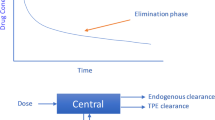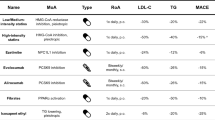Abstract
Lipoprotein apheresis is an extracorporeal therapy whereby apo B-containing lipoproteins (LDL, vLDL, and Lp(a)) are selectively removed from the plasma of a patient. It is a variation of plasma exchange, which non-selectively removes all plasma proteins. Lipoprotein apheresis is most commonly used to treat patients with familial hypercholesterolemia, but is also often used for other hyperlipidemic patients, including those with elevated Lp(a), to limit and/or reverse the atherosclerotic complications of high cholesterol. Herein, we provide an overview of lipoprotein apheresis including indications, techniques, efficacy, and adverse events, as well as guidelines and other considerations important for selection of patients for this therapy.


Similar content being viewed by others
References
Papers of particular interest, published recently, have been highlighted as: • Of importance
Adams WS, Blahd WH, Bassett SH. A method of human plasmapheresis. Proc Soc Exp Biol Med. 1952;80:377–9.
Reynolds WA. Late report of the first case of plasmapheresis for Waldenstrom’s macroglobulinemia. JAMA. 1981;245:606–7.
Winters JL. Selective extraction of plasma constituents. In: McLeod BC, Szczepiorkowski ZM, Weinstein R, Winters JL, editors. Apheresis: principles and practice. Bethesda, MD: AABB Press; 2010. p. 427–36.
Schwartz J, Winters JL, Padmanabhan A, Balogun RA, Delaney M, Linenberger ML, et al. Guidelines on the use of therapeutic apheresis in clinical practice—evidence-based approach from the Writing Committee of the American Society for Apheresis: the sixth special issue. J Clin Apher. 2013;28:145–284. This reference contains evidence based reviews of lipoprotein apheresis and summaries of diseases where lipoprotein apheresis may be performed.
Turnberg LA, Mahoney MP, Gleeson MH, Freeman CB, Gowenlock AH. Plasmaphoresis and plasma exchange in the treatment of hyperlipaemia and xanthomatous neuropathy in patients with primary biliary cirrhosis. Gut. 1972;13:976–81.
Thompson GR, Lowenthal R, Myant NB. Plasma exchange in the management of homozygous familial hypercholesterolaemia. Lancet 1975; 1208-11.
Lupien PJ, Moorjani S, Awad J. A new approach to the management of familial hypercholesterolaemia removal of plasma-cholesterol based on the principle of affinity chromatography. Lancet 1976; 1261-4.
Bambauer R, Bambauer C, Lehmann B, Latza R, Schiel R. LDL-apheresis: technical and clinical aspects. ScientificWorldJournal. 2012;2012:314283.
Klingel R, Mausfeld P, Fassbender C, Goehlen B. Lipidfiltration—safe and effective methodology to perform lipid-apheresis. Transfus Apher Sci. 2004;30:245–54.
Matsuda Y, Malchesky PS, Nose Y. Assessment of currently available low-density lipoprotein apheresis systems. Artif Organs. 1994;18:93–9.
Kroon AA, van’t Hof MA, Demacker PN, Stalenhoef AF. The rebound of lipoproteins after LDL-apheresis. Kinetics and estimation of mean lipoprotein levels. Atherosclerosis. 2000;152:519–26.
Armstrong VW, Schuff-Werner P, Eisenhauer T, Helmhold M, Stix M, Seidel D. Heparin extracorporeal LDL precipitation (HELP): an effective apheresis procedure for lowering Lp(a) levels. Chem Phys Lipids. 1994;67–68:315–21.
Mabuchi H, Koizumi J, Shimizu M, Kajinami K, Miyamoto S, Ueda K, et al. Long-term efficacy of low-density lipoprotein apheresis on coronary heart disease in familial hypercholesterolemia. Hokuriku-FH-LDL-Apheresis Study Group. Am J Cardiol. 1998;82:1489–95.
Kroon AA, Aengevaeren WR, van der Werf T, Uijen GJ, Reiber JH, Bruschke AV, et al. LDL-Apheresis Atherosclerosis Regression Study (LAARS). Effect of aggressive versus conventional lipid lowering treatment on coronary atherosclerosis. Circulation. 1996;93:1826–35.
Dihazi H, Koziolek MJ, Sollner T, Kahler E, Klingel R, Neuhoff R, et al. Protein adsorption during LDL-apheresis: proteomic analysis. Nephrol Dial Transplant. 2008;23:2925–35.
Knisel W, Di Nicuolo A, Pfohl M, Muller H, Risler T, Eggstein M, et al. Different effects of two methods of low-density lipoprotein apheresis on the coagulation and fibrinolytic systems. J Intern Med. 1993;234:479–87.
Bosch T, Wendler T, Jaeger BR, Samtleben W. Improvement of hemorheology by DALI apheresis: acute effects on plasma viscosity and erythrocyte aggregation in hypercholesterolemic patients. Ther Apher. 2001;5:372–6.
Suckfull M, Hearing Loss Study G. Fibrinogen and LDL apheresis in treatment of sudden hearing loss: a randomised multicentre trial. Lancet. 2002;360:1811–7.
Jaeger BR, Goehring P, Schirmer J, Uhrig S, Lohse P, Kreuzer E, et al. Consistent lowering of clotting factors for the treatment of acute cardiovascular syndromes and hypercoagulability: a different pathophysiological approach. Ther Apher. 2001;5:252–9.
Kojima S. Low-density lipoprotein apheresis and changes in plasma components. Ther Apher. 2001;5:232–8.
Sachais BS, Katz J, Ross J, Rader DJ. Long-term effects of LDL apheresis in patients with severe hypercholesterolemia. J Clin Apher. 2005;20:252–5.
Koziolek MJ, Hennig U, Zapf A, Bramlage C, Grupp C, Armstrong VW, et al. Retrospective analysis of long-term lipid apheresis at a single center. Ther Apher Dial. 2010;14:143–52.
Adamski J, Jamensky L, Ross J, Siegel DL, Sachais BS. Anaphylactoid-like reactions in a patient with HyperLp(a)lipidemia undergoing LDL apheresis with dextran sulfate adsorption and herbal therapy with the spice turmeric. J Clin Apher. 2010;25:354–7.
Leitman SF, Boltansky H, Alter HJ, Pearson FC, Kaliner MA. Allergic reactions in healthy plateletpheresis donors caused by sensitization to ethylene oxide gas. N Engl J Med. 1986;315:1192–6.
Cashin-Hemphill L, Noone M, Abbott JF, Waksmonski CA, Lees RS. Low-density lipoprotein apheresis therapy during pregnancy. Am J Cardiol. 2000;86:1160. A10.
Vishwanath R, Hemphill LC. Familial hypercholesterolemia and estimation of US patients eligible for low-density lipoprotein apheresis after maximally tolerated lipid-lowering therapy. J Clin Lipidol. 2014;8:18–28.
Jaeschke R, Guyatt GH, Dellinger P, Schunemann H, Levy MM, Kunz R, et al. Use of GRADE grid to reach decisions on clinical practice guidelines when consensus is elusive. BMJ. 2008;337:a744.
Grundy SM, Cleeman JI, Merz CN, Brewer Jr HB, Clark LT, Hunninghake DB, et al. Implications of recent clinical trials for the national cholesterol education program adult treatment panel III guidelines. Circulation. 2004;110:227–39.
Thompson GR, Group H-ULAW. Recommendations for the use of LDL apheresis. Atherosclerosis. 2008;198:247–55.
Nordestgaard BG, Chapman MJ, Humphries SE, Ginsberg HN, Masana L, Descamps OS, et al. Familial hypercholesterolaemia is underdiagnosed and undertreated in the general population: guidance for clinicians to prevent coronary heart disease: consensus statement of the European Atherosclerosis Society. Eur Heart J. 2013;34:3478–90a.
Goldberg AC, Hopkins PN, Toth PP, Ballantyne CM, Rader DJ, Robinson JG, et al. National lipid association expert panel on Familial H. Familial hypercholesterolemia: screening, diagnosis and management of pediatric and adult patients: clinical guidance from the National Lipid association expert panel on familial hypercholesterolemia. J Clin Lipidol. 2011;5:S1–8.
Gordon BR, Kelsey SF, Bilheimer DW, Brown DC, Dau PC, Gotto Jr AM, et al. Treatment of refractory familial hypercholesterolemia by low-density lipoprotein apheresis using an automated dextran sulfate cellulose adsorption system. The Liposorber Study Group. Am J Cardiol. 1992;70:1010–6.
Gordon BR, Kelsey SF, Dau PC, Gotto Jr AM, Graham K, Illingworth DR, et al. Long-term effects of low-density lipoprotein apheresis using an automated dextran sulfate cellulose adsorption system. Liposorber Study Group. Am J Cardiol. 1998;81:407–11.
Matsuzaki M, Hiramori K, Imaizumi T, Kitabatake A, Hishida H, Nomura M, et al. Intravascular ultrasound evaluation of coronary plaque regression by low density lipoprotein-apheresis in familial hypercholesterolemia: the low density lipoprotein-apheresis coronary morphology and reserve trial (LACMART). J Am Coll Cardiol. 2002;40:220–7. This reference contains evidence that lipoprotein apheresis may result in regression of atherosclerotic plaque. It is also a rare, randomized study in lipoprotein apheresis.
Jaeger BR, Richter Y, Nagel D, Heigl F, Vogt A, Roeseler E, et al. Group of clinical I. Longitudinal cohort study on the effectiveness of lipid apheresis treatment to reduce high lipoprotein(a) levels and prevent major adverse coronary events. Nat Clin Pract Cardiovasc Med. 2009;6:229–39.
Leebmann J, Roeseler E, Julius U, Heigl F, Spitthoever R, Heutling D, et al. Lipoprotein apheresis in patients with maximally tolerated lipid-lowering therapy, lipoprotein(a)-hyperlipoproteinemia, and progressive cardiovascular disease: prospective observational multicenter study. Circulation. 2013;128:2567–76. This prospective observational study contains evidence that lipoprotein aphersis improves cardiovascular outcomes in patients with elevated Lp(a) but normal LDL levels.
Tamura K, Tsurumi-Ikeya Y, Wakui H, Maeda A, Ohsawa M, Azushima K, et al. Therapeutic potential of low-density lipoprotein apheresis in the management of peripheral artery disease in patients with chronic kidney disease. Ther Apher Dial. 2013;17:185–92.
Kroon AA, van Asten WN, Stalenhoef AF. Effect of apheresis of low-density lipoprotein on peripheral vascular disease in hypercholesterolemic patients with coronary artery disease. Ann Intern Med. 1996;125:945–54.
Winters JL, Cooper LT, Ratcliffe NR, Wu Y, Moriarty PM. National heart, lung, and blood institute state of the science symposium in therapeutic apheresis—therapeutic apheresis in cardiovascular disease. J Clin Apher 2014.
Hovland A, Lappegard KT, Mollnes TE. LDL apheresis and inflammation—implications for atherosclerosis. Scand J Immunol. 2012;76:229–36.
Kobayashi S, Oka M, Moriya H, Maesato K, Okamoto K, Ohtake T. LDL-apheresis reduces P-selectin, CRP and fibrinogen—possible important implications for improving atherosclerosis. Ther Apher Dial. 2006;10:219–23.
Rovers C, Netea MG, de Bont N, Demacker PN, Jacobs C, Kullberg BJ, et al. LPS-induced cytokine production and expression of beta2-integrins and CD14 by peripheral blood mononuclear cells of patients with homozygous familial hypercholesterolemia. Atherosclerosis. 1998;141:99–105.
Ramunni A, Burzo M, Verno L, Brescia P. Pleiotropic effects of LDL apheresis. Atheroscler Suppl. 2009;10:53–5.
Moriarty PM, Gibson CA, Kensey KR, Hogenauer W. Effect of low-density lipoprotein cholesterol apheresis on blood viscosity. Am J Cardiol. 2004;93:1044–6.
Compliance with Ethics Guidelines
Conflict of Interest
VG Bohj declares no conflicts of interest.
BS Sachais has received an honorarium from Kanaka Pharma America.
Human and Animal Rights and Informed Consent
This article does not contain any studies with human or animal subjects performed by any of the authors.
Author information
Authors and Affiliations
Corresponding author
Additional information
This article is part of the Topical Collection on Nonstatin Drugs
Rights and permissions
About this article
Cite this article
Bhoj, V.G., Sachais, B.S. Lipoprotein Apheresis. Curr Atheroscler Rep 17, 39 (2015). https://doi.org/10.1007/s11883-015-0516-7
Published:
DOI: https://doi.org/10.1007/s11883-015-0516-7




